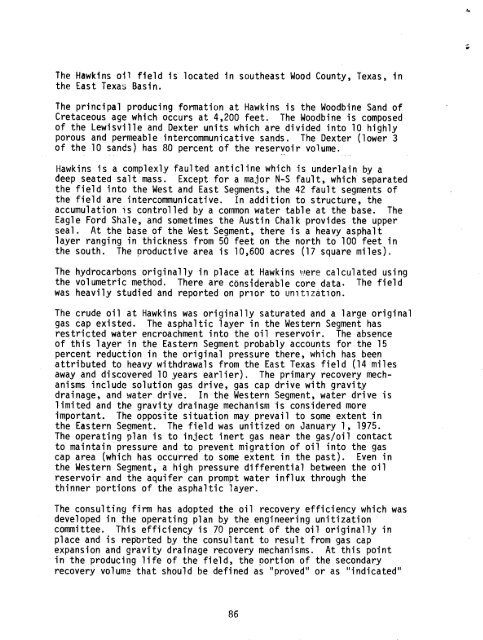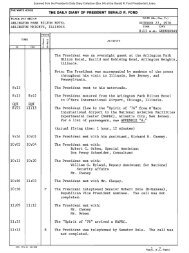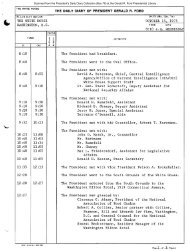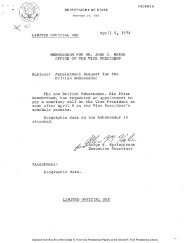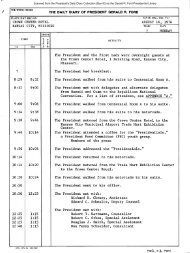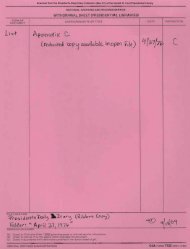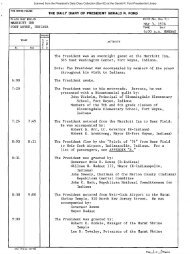October 31, 1975 - Gerald R. Ford Presidential Library and Museum
October 31, 1975 - Gerald R. Ford Presidential Library and Museum
October 31, 1975 - Gerald R. Ford Presidential Library and Museum
You also want an ePaper? Increase the reach of your titles
YUMPU automatically turns print PDFs into web optimized ePapers that Google loves.
The Hawkins oil field is located in southeast Wood County, Texas. in<br />
the East Texaa Basin.<br />
The principal producing formation at Hawkins is the Woodbine S<strong>and</strong> of<br />
Cretaceous age which occurs at 4,200 feet. The Woodbine is composed<br />
of the Lewisville <strong>and</strong> Dexter units which are divided into 10 highly<br />
porous <strong>and</strong> permeable intercommunicative s<strong>and</strong>s. The Dexter (lower 3<br />
of the 10 s<strong>and</strong>s) has 80 percent of the reservoir volume.<br />
Hawkins is a complexly faulted anticline which is underlain by a<br />
deep seated salt mass. Except for a major N-S fault, which separated<br />
the field into the West <strong>and</strong> East Segments, the 42 fault segments of<br />
the field are intercommunicative. In addition to structure, the<br />
accumulation is controlled by a common water table at the base. The<br />
Eagle <strong>Ford</strong> Shale, <strong>and</strong> sometimes the Austin Chalk provides the upper<br />
seal. At the base of the West Segment, there is a heavy asphalt<br />
layer ranging in thickness from 50 feet on the north to 100 feet in<br />
the south. The productive area is 10,600 acres (17 square miles).<br />
The hydrocarbons originally in place at Hawkins were calculated using<br />
the volumetric method. There are considerable core data. The field<br />
was heavily studied <strong>and</strong> reported on prlor to unltlzation.<br />
The crude oil at Hawkins was originally saturated <strong>and</strong> a large original<br />
gas cap existed. The asphaltic layer in the Western Segment has<br />
restricted watp.r encroachment into the oil reservoir. The absence<br />
of this layer in the Eastern Segment probably accounts for the 15<br />
percent reduction in the original pressure there, which has been<br />
attributed to heavy withdrawals from the East Texas field (14 miles<br />
away <strong>and</strong> discovered 10 years earlier). The primary recovery mechanisms<br />
include solution gas drive, gas cap drive with gravity<br />
drainage, <strong>and</strong> water drive. In the Western Segment, water drive is<br />
limited <strong>and</strong> the gravity drainage mechanism is considered more<br />
important. The opposite situation may prevail to some extent in<br />
the Eastern SeQment. The field was unitized on January 1, <strong>1975</strong>.<br />
The operating plan is to inject inert gas near the gas/oil contact<br />
to maintain pressure <strong>and</strong> to prevent migration of oil into the gas<br />
cap area (which has occurred to some extent in the past). Even in<br />
the Western Segment, a high pressure differential between the oil<br />
reservoir <strong>and</strong> the aquifer can prompt water influx through the<br />
thinner portions of the asphaltic 1ayer.<br />
The consulting firm has adopted the oil recovery efficiency which was<br />
developed in the operating plan by the engineering unitization<br />
committee. This efficiency is 70 percent of the oil originally in<br />
place <strong>and</strong> is reported by the consultant to result from gas cap<br />
expansion <strong>and</strong> gravity drainage recovery mechanisms. At this pOint<br />
in the producing life of the field, the portion of the secondary<br />
recovery volume that should be defined as "proved" or as "indicated"<br />
86


